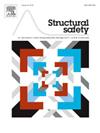Variance reduction function for a potential inclined slip line in a spatially variable soil
Abstract
Variance reduction function for a spatially variable soil property is an important factor that affects the spatial average-based characteristic value, which in turn influences the design of a geotechnical structure in the context of Eurocode 7. This study derives the theoretical and approximate variance reduction functions (VRFs) for a potential inclined slip line in a spatially variable soil. Only stationary random fields are studied but more general spatial variability characteristics including smoothness and hole effect are considered. First, the closed-form one-dimensional (1D) VRFs are investigated, including the VRFs for classical one-parameter autocorrelation models, the non-classical two-parameter Whittle-Matérn (WM) model, and the most general three-parameter cosine Whittle-Matérn (CosWM) model proposed to date. It is found that closed-form solutions are not available or not practical to compute in general and the simple approximate VRF (equal to scale of fluctuation/averaging length) is not adequate for the non-classical autocorrelation models (WM and CosWM). Two approximate VRFs are developed in this study for the 1D WM and 1D CosWM models. For a spatial average over an inclined line, this paper derives the theoretical scales of fluctuation (SOFs) and VRFs for five commonly used 2D autocorrelation models. The theoretical solutions show that the equivalent SOFs proposed in the literature are only applicable under special conditions which are clarified in this paper. More general approximations for the VRF over an inclined line are proposed. The range of applicability for each approximation is stated. The proposed approximate VRFs are shown to be reasonably accurate when they are applied to the spatial average-based characteristic value and for the design of a vertical pile and an inclined soil nail.

 求助内容:
求助内容: 应助结果提醒方式:
应助结果提醒方式:


